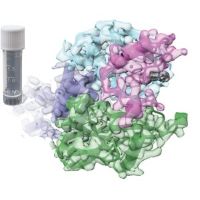Specification
| Description | Recombinant protein from the full-length sequence of Homo sapiens proteasome 20S subunit beta 9 (PSMB9) (NM_002800). |
| Organism | Homo sapiens (Human) |
| Expression Host | Human Cells |
| Tag Info | His or DYKDDDDK. Please contact us if you need further information or require specific designed tag. |
| Purity | Greater than 90% by SDS-PAGE gel |
| Uniprot ID | P28065 |
| Entry Name | PSB9_HUMAN |
| Gene Names | PSMB9 LMP2 PSMB6i RING12 |
| Alternative Gene Names | LMP2 PSMB6i RING12 |
| Alternative Protein Names | Proteasome subunit beta type-9 (EC 3.4.25.1) (Low molecular mass protein 2) (Macropain chain 7) (Multicatalytic endopeptidase complex chain 7) (Proteasome chain 7) (Proteasome subunit beta-1i) (Really interesting new gene 12 protein) |
| Application | Antigens, Western, ELISA and other in vitro binding or in vivo functional assays, and protein-protein interaction studies; For research & development use only! |
| Buffer | Purified protein formulated in a sterile solution of PBS buffer, pH7.2, without any preservatives |
| Endotoxin | Endotoxin level is < 0.1 ng/µg of protein (<1EU /µg) |
| Length | 219 |
| Molecular Weight(Da) | 23264 |
| Protein Sequence | (The sequence of expressed protein may have some variation from the sequence shown below. Please contact us for the exact sequence.) MLRAGAPTGDLPRAGEVHTGTTIMAVEFDGGVVMGSDSRVSAGEAVVNRVFDKLSPLHERIYCALSGSAADAQAVADMAAYQLELHGIELEEPPLVLAAANVVRNISYKYREDLSAHLMVAGWDQREGGQVYGTLGGMLTRQPFAIGGSGSTFIYGYVDAAYKPGMSPEECRRFTTDAIALAMSRDGSSGGVIYLVTITAAGVDHRVILGNELPKFYDE |
Background
| Function | FUNCTION: The proteasome is a multicatalytic proteinase complex which is characterized by its ability to cleave peptides with Arg, Phe, Tyr, Leu, and Glu adjacent to the leaving group at neutral or slightly basic pH. The proteasome has an ATP-dependent proteolytic activity. This subunit is involved in antigen processing to generate class I binding peptides. Replacement of PSMB6 by PSMB9 increases the capacity of the immunoproteasome to cleave model peptides after hydrophobic and basic residues. {ECO:0000269|PubMed:8163024}. |
| Pathway | |
| Protein Families | Peptidase T1B family |
| Tissue Specificity |
QC Data
| Note | Please contact us for QC Data |
| Product Image (Reference Only) |  |

